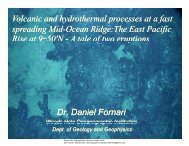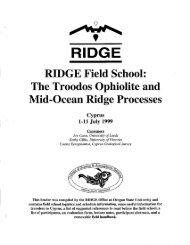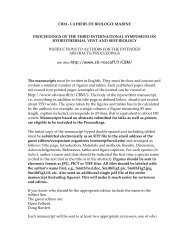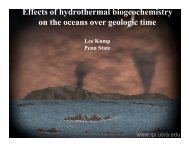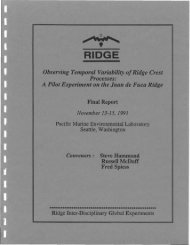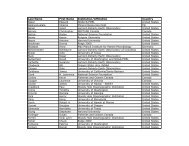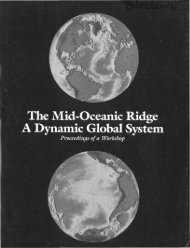NSF Forms - Ridge 2000 Program
NSF Forms - Ridge 2000 Program
NSF Forms - Ridge 2000 Program
Create successful ePaper yourself
Turn your PDF publications into a flip-book with our unique Google optimized e-Paper software.
There is thus a rich array of problems that can be addressed by detailed study of ELSC samples<br />
that (1) are sampled with the benefit of high resolution side scan and bathymetry and therefore are<br />
very likely to be young and the best candidates to preserve U-series disequilibria; (2) exhibit large<br />
and systematic variations in fluid signature as recorded by U/Th, Ba/La and Pb isotopes, all<br />
pertinent to the investigation and interpretation of U-series data; and (3) have as large variations in<br />
( 238 U/ 232 Th) that correlate with water contents in the northernmost ridge segment ELSC 1, as are<br />
present in the south. Specific problems we will be able to elucidate include:<br />
• Do 226 Ra excesses correlate with Ba/La and Ba/Th for our sample suite? Is the spike in Ba<br />
observed at 21°S associated with an increase in 226 Ra excess? If found, this would be evidence of<br />
control of Ra excess by a subduction component, even in the back-arc. This would provide a new<br />
constraint on the timing hypotheses for Ra excesses, because the back-arc is much farther from a<br />
source of fluids that would lead to correlated Ra and Ba excesses. If such a correlation exists, then<br />
one needs to imagine very rapid transport independent of distance from the volcanic front, which<br />
would be problematic, possibly necessitating alternative models for the Ra excess occurring just<br />
beneath the sites of magmatism. Thus we can test the hypothesis that the Ba- 226 Ra/ 230 Th correlation<br />
should disappear in the back-arc setting, and that back-arc 226 Ra excesses would be associated with<br />
melting column effects as at open ocean ridges.<br />
• U-excesses for the Tonga volcanic front are interpreted as reflecting a processing age in the<br />
mantle wedge of 30,000years. We have a large variation in U/Th in ELSC 1, much farther from the<br />
arc. Do these samples lie on the same trend as the arc, suggesting a mixing origin for all of the<br />
data? Do they show an older apparent age, which might be expected for a longer fluid residence<br />
time with increasing distance form the trench? Are they instead dominated by melting column<br />
processes, and hence show no correlation between U-excess and other indicators of a slab<br />
component, or possibly even show Th excess at the same time as the U-enrichment from a slab<br />
component? Depending on the results, these data will impact the understanding and interpretation of<br />
the apparent ages of fluid transport inferred from arc U-series studies.<br />
• For samples in the north with no apparent slab component, are Th and Ra excesses<br />
consistent with the melting column processes of open ocean ridges, or do they differ, suggesting a<br />
different melting regime environment? This will test the arguments of Kelley et al., [in press] and<br />
Langmuir et al., [in press] for differences in the melting regime in the back-arc as compared to open<br />
ocean environment.<br />
All these interpretations will be furthered by the extensive geochemical data sets obtained on the<br />
same samples. Our sample set combines exceptional spatial and tectonic control with high quality<br />
data from our on-going studies of major elements [Bezos et al., 2004], trace elements [Bezos et al.,<br />
2005], radiogenic isotopes [Escrig et al., 2005], helium isotopes [Goddard et al., 2005] and volatiles<br />
[Michael et al., 2005]. Our proposed work will provide the most exhaustive and complete data set in<br />
a back-arc environment, and may lead to significant new constraints on the interpretation of U-<br />
series data at convergent margins, and our understanding of the nature and timing of formation and<br />
delivery of subduction components to the surface.<br />
We are well aware that one of these questions requires very young samples that preserve their<br />
eruptive 226 Ra disequilibria. Such recent volcanism has often been the case at ocean spreading<br />
centers, and simple geological considerations are supportive of this possibility for our samples as<br />
well. Based on the high-resolution side scan and bathymetry, the precise and short dredge tracks,<br />
and existence of many very well located rock core samples with sufficient glass, we believe that<br />
most sample locations are within the zone of youngest volcanism. Certainly within the areas where<br />
we have SM<strong>2000</strong> bathymetry and where Jason samples were collected, we are within such a very<br />
D-10<br />
0649641





